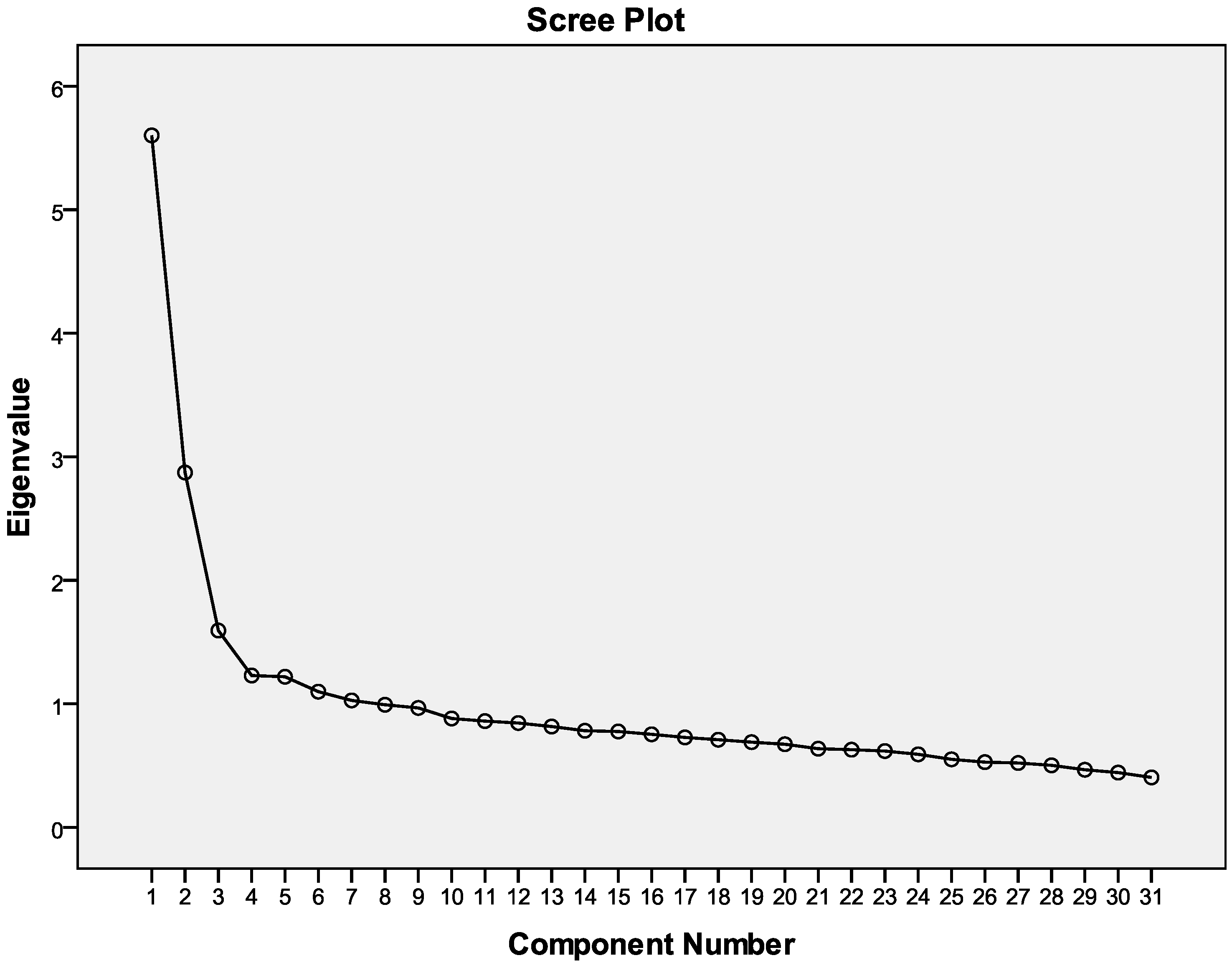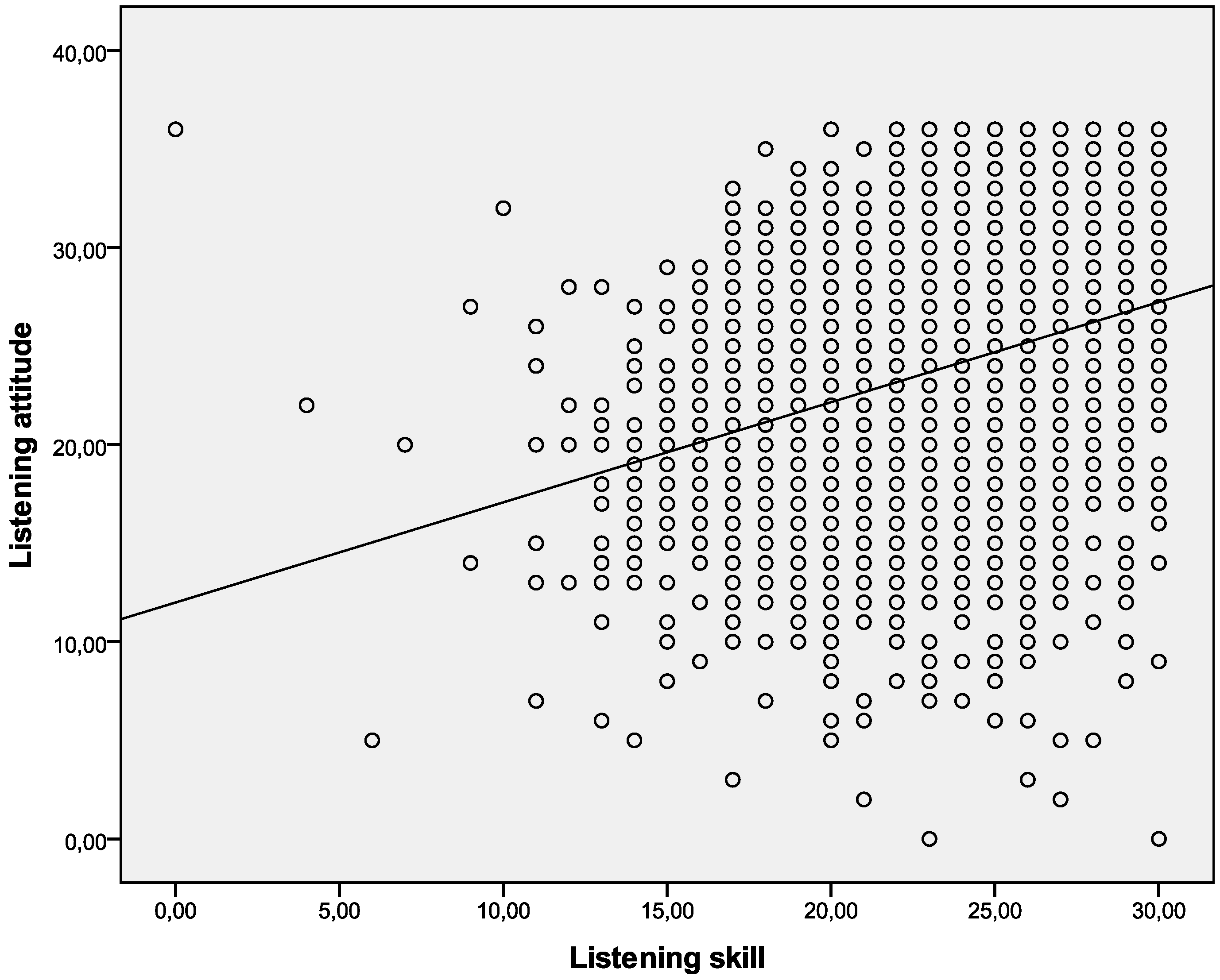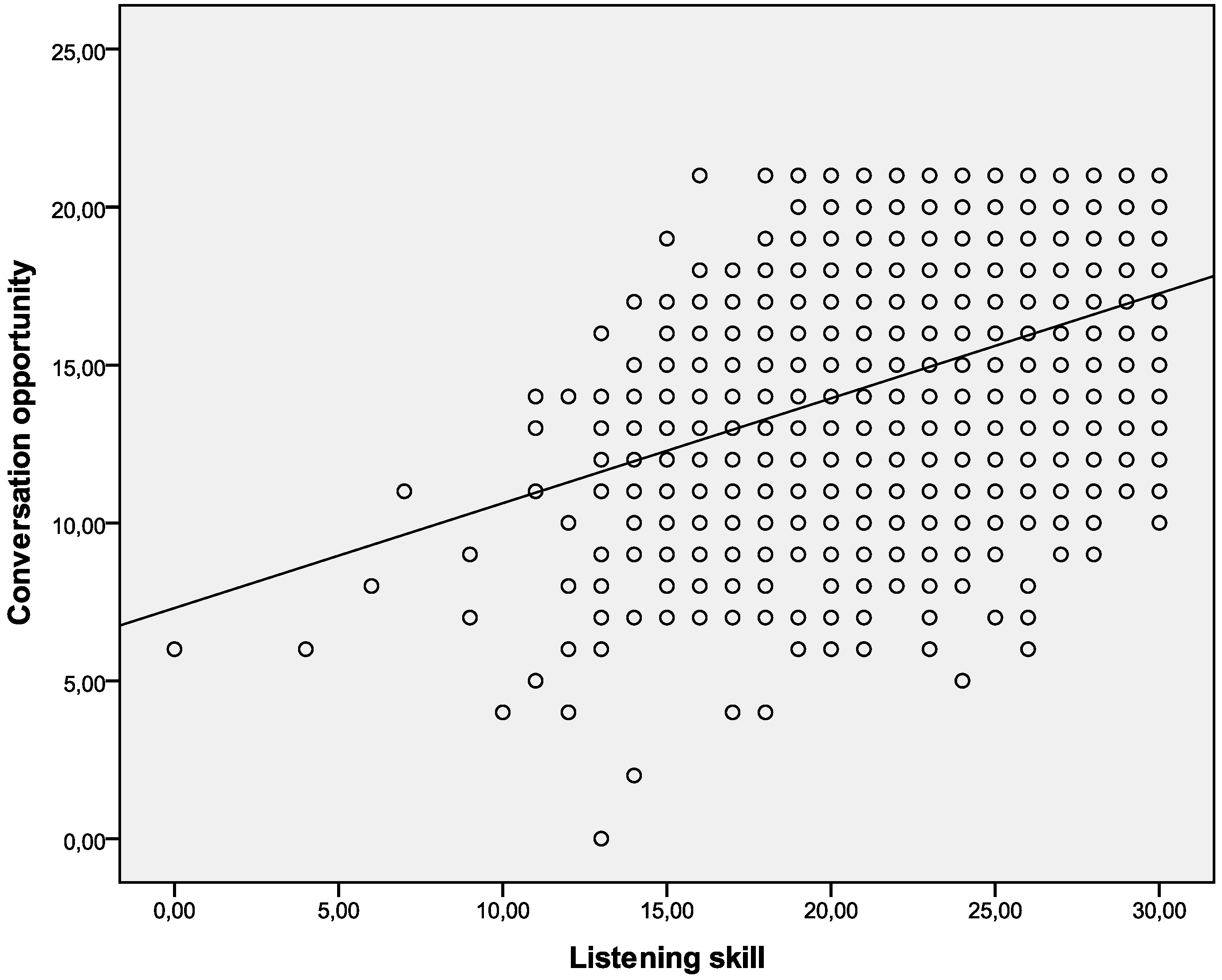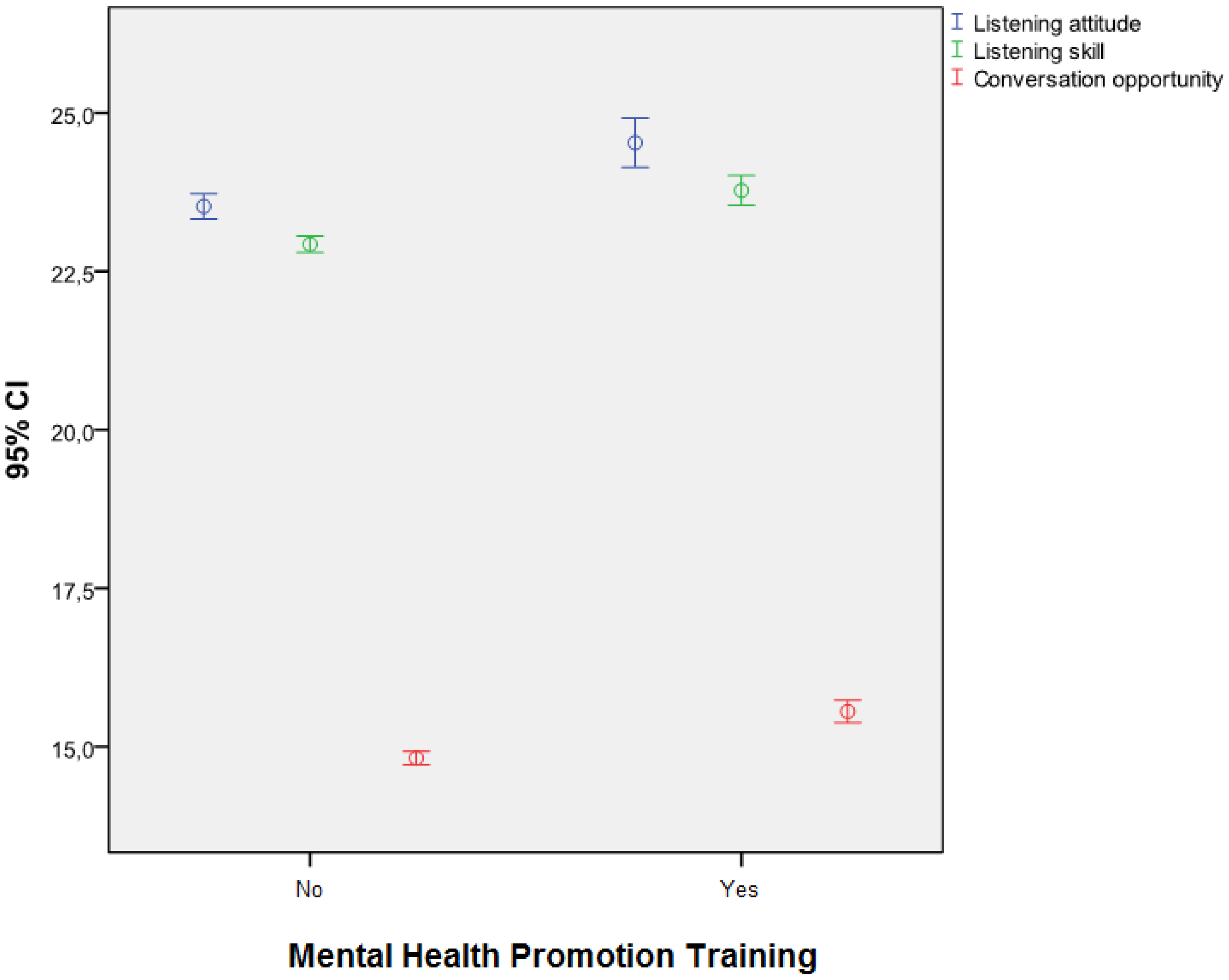Active Listening Attitude Scale (ALAS): Reliability and Validity in a Nationwide Sample of Greek Educators
Abstract
:1. Introduction
1.1. Teachers’ Listening and Active Listening Skills
1.2. Active Listening Attitude Scale
2. Materials and Methods
2.1. Participants
2.2. Measures
2.2.1. Active Listening
2.2.2. Demographic Information
2.3. Procedure
2.4. Translation
3. Statistical Analysis
4. Results
5. Discussion
6. Strengths and Limitations
7. Conclusions
Acknowledgments
Author Contributions
Conflicts of Interest
Abbreviations
| ALAS | Active Listening Attitude Scale; |
| CFA | Confirmatory Factor Analysis; |
| CFI | Comparative Fit Index; |
| EFA | Exploratory Factor Analysis; |
| GFI | Goodness of Fit Index; |
| RMSEA | Root Mean Square Error of Approximation; |
| χ2 | chi square. |
References
- Graham D. Bodie. “The understudied nature of listening in interpersonal communication: Introduction to a special issue.” International Journal of Listening 25 (2011): 1–9. [Google Scholar] [CrossRef]
- Marylin H. Lewis, and Lamar N. Reinsch. “Listening in organizational environments.” Journal of Business Communication 25 (1988): 49–67. [Google Scholar] [CrossRef]
- Kathryn Roberston. “Active listening: More than just paying attention.” Australian Family Physician 34 (2005): 1053–55. [Google Scholar]
- Graham D. Bodie, Kellie St. Cyr, Michelle Pence, Michael Rold, and James Honeycutt. “Listening competence in initial interactions I: Distinguishing between what listening is and what listeners do.” International Journal of Listening 26 (2012): 1–28. [Google Scholar] [CrossRef]
- Richard L. Street, Gregory Makoul, Neeraj K. Arora, and Ronald M. Epstein. “How does communication heal? Pathways linking clinician-patient communication to health outcomes.” Patient Education and Counseling 74 (2009): 295–301. [Google Scholar] [CrossRef] [PubMed]
- Carl R. Rogers. “The necessary and sufficient conditions of therapeutic personality change.” Journal of Consulting Psychology 21 (1957): 95–103. [Google Scholar] [CrossRef] [PubMed]
- Carl R. Rogers, and Richard E. Farson. “Active listening.” Organizational Psychology, 1979, 168–80. [Google Scholar]
- Thomas Gordon, and Noel Burch. Teacher Effectiveness Training: The Program Proven to Help Teachers Bring Out the Best in Students of All Ages. New York: (CA) Three Rivers Press, 2003. [Google Scholar]
- David McNaughton, Dawn Hamlin, John McCarthy, Derlene Head-Reeves, and Mary Schreiner. “Learning to listen: Teaching an active listening strategy to preservice education professionals.” Topics in Early Childhood Special Education 27 (2008): 223–31. [Google Scholar] [CrossRef]
- Weger Harry Jr., Gina R. Castle, and Melissa C. Emmett. “Active listening in peer interviews: The influence of message paraphrasing on perceptions of listening skill.” The International Journal of Listening 24 (2010): 34–49. [Google Scholar]
- Janet B. Bavelas, Linda Coates, and Trudy Johnson. “Listeners as co-narrators.” Journal of Personality and Social Psychology 79 (2000): 941–52. [Google Scholar] [CrossRef] [PubMed]
- Sashiko Mineyama, Akizumi Tsutsumi, Soshi Takao, Kyoko Nishiuti, and Norito Kawakami. “Supervisors’ attitudes and skills for active listening with regard to working conditions and psychological stress reactions among subordinate workers.” Journal of Occupational Health 49 (2007): 81–87. [Google Scholar] [CrossRef] [PubMed]
- Thijs Fassaert, Sandra van Dulmen, François Schellevis, and Josien Bensing. “Active listening in medical consultations: Development of the Active Listening Observation Scale (ALOS-global).” Patient Education and Counseling 68 (2007): 258–64. [Google Scholar] [CrossRef] [PubMed]
- Laura Santos, and Heloísa de Carvalho Torres. “Educational practices in diabetes mellitus: Understanding the skills of health professionals.” Texto & Contexto-Enfermagem 21 (2012): 574–80. [Google Scholar] [CrossRef]
- Anna Wloszczak-Szubzda, and Miroslaw Jerzy Jarosz. “Professional communication competences of nurses.” Annals of Agricultural and Environmental Medicine 19 (2012): 601–7. [Google Scholar] [PubMed]
- Shinya Kubota, Noria Mishima, and Shoji Nagata. “A study of the effects of active listening on listening attitudes of middle managers.” Journal of Occupational Health 46 (2004): 60–67. [Google Scholar] [CrossRef] [PubMed]
- Erik Rautalinko, and Hans-Olof Lisper. “Effects of training reflective listening in a corporate setting.” Journal of Business and Psychology 18 (2004): 281–99. [Google Scholar] [CrossRef]
- John M. Gottman, James Coan, Sybil Carrere, and Catherine Swanson. “Predicting marital happiness and stability from newlywed interactions.” Journal of Marriage and the Family 60 (1998): 5–22. [Google Scholar] [CrossRef]
- McArthur Hafen Jr., and D. Russell Crane. “When marital interaction and intervention researchers arrive at different points of view: The active listening controversy.” Journal of Family Therapy 25 (2003): 4–14. [Google Scholar] [CrossRef]
- Monisha Pasupathi, Laura L. Carstensen, Robert W. Levenson, and John M. Gottman. “Responsive listening in long-married couples: A psycholinguistic perspective.” Journal of Nonverbal Behavior 23 (1999): 173–93. [Google Scholar] [CrossRef]
- Todd W. Leibert. “The dimensions of common factors in counseling.” International Journal for the Advancement of Counselling 33 (2011): 127–38. [Google Scholar] [CrossRef]
- Dana Heller Levitt. “Active listening and counselor self-efficacy: Emphasis on one microskill in beginning counselor training.” The Clinical Supervisor 20 (2002): 101–15. [Google Scholar] [CrossRef]
- Bruce Phillips. “Reformulating dispute narratives through active listening.” Mediation Quarterly 17 (1999): 161–80. [Google Scholar] [CrossRef]
- Donald J. Boudreau, Erik Cassell, and Abraham Fuks. “Preparing medical students to become attentive listeners.” Medical Teacher 31 (2009): 22–29. [Google Scholar] [CrossRef] [PubMed]
- Ronda F. Brown, Phyllis N. Butow, Michael Henman, Stewart M. Dunn, Francis Boyle, and Martin H. Tattersall. “Responding to the active and passive patient: Flexibility is the key.” Health Expectations 5 (2002): 236–45. [Google Scholar] [CrossRef] [PubMed]
- Nancy Edwards, Wendy E. Peterson, and Barbara L. Davies. “Evaluation of a multiple component intervention to support the implementation of a ‘Therapeutic Relationships’ best practice guideline on nurses’ communication skills.” Patient Education and Counseling 63 (2006): 3–11. [Google Scholar] [CrossRef] [PubMed]
- Dorothy Ann Gilbert. “Coordination in nurses’ listening activities and communication about patient-nurse relationships.” Research in Nursing & Health 27 (2004): 447–57. [Google Scholar] [CrossRef] [PubMed]
- Gregory M. Vecchi, Vincent B. van Hasselt, and Stephen J. Romano. “Crisis (hostage) negotiation: Current strategies and issues in high-risk conflict resolution.” Aggression and Violent Behavior 10 (2005): 533–51. [Google Scholar] [CrossRef]
- Tanya Drollinger, Lucette B. Comer, and Patricia T. Warrington. “Development and validation of the active empathetic listening scale.” Psychology & Marketing 23 (2006): 161–80. [Google Scholar] [CrossRef]
- Jan Flynn, Tuula-Riitta Valikoski, and Jennie Grau. “Listening in the business context: Reviewing the state of research.” International Journal of Listening 22 (2008): 141–51. [Google Scholar] [CrossRef]
- Kyoko Nishiuchi, Akizumi Tsutsumi, Soshi Takao, Sachiko Mineyama, and Norito Kawakami. “Effects of an education program for stress reduction on supervisor knowledge, attitudes, and behavior in the workplace: A randomized controlled trial.” Journal of Occupational Health 49 (2007): 190–98. [Google Scholar] [CrossRef] [PubMed]
- Rosemary P. Ramsey, and Ravipreet S. Sohi. “Listening to your customers: The impact of perceived salesperson listening behavior on relationship outcomes.” Journal of the Academy of Marketing Science 25 (1997): 127–37. [Google Scholar] [CrossRef]
- Shinya Kubota, Norio Mishima, Akira Ikemi, and Syohji Nagata. “A Research in the Effects of Active Listening on Corporate Mental Health Training.” Journal of Occupational Health 39 (1997): 274–79. [Google Scholar] [CrossRef]
- Norio Mishima, Shinya Kubota, and Shoji Nagata. “The development of a questionnaire to assess the attitude of active listening.” Journal of Occupational Health 42 (2000): 111–18. [Google Scholar] [CrossRef]
- Mary Doveston. “Developing capacity for social and emotional growth: An action research project.” Pastoral Care in Education 25 (2007): 46–54. [Google Scholar] [CrossRef]
- Heather Noel Fedesco. “The Impact of (In) effective Listening on Interpersonal Interactions.” International Journal of Listening 29 (2015): 103–6. [Google Scholar] [CrossRef]
- Mary Renck Jalongo. “Promoting active listening in the classroom.” Childhood Education 72 (1995): 13–18. [Google Scholar] [CrossRef]
- Mary Renck Jalongo. “Listening in early childhood: An interdisciplinary review of the literature.” International Journal of Listening 24 (2010): 1–18. [Google Scholar] [CrossRef]
- Andrew D. Wolvin, and Carolyn G. Coakley. “Listening education in the 21st century.” International Journal of Listening 14 (2000): 143–52. [Google Scholar] [CrossRef]
- Karina J. Lloyd, Diana Boer, Avraham N. Kluger, and Sven C. Voelpel. “Building Trust and Feeling Well: Examining Intraindividual and Interpersonal Outcomes and Underlying Mechanisms of Listening.” International Journal of Listening 29 (2015): 12–29. [Google Scholar] [CrossRef]
- Dotan R. Castro, Cohen Alex, Gilad Tohar, and Avraham N. Kluger. “The Role of Active Listening in Teacher-Parent Relations and the Moderating Role of Attachment Style.” International Journal of Listening 27 (2013): 136–45. [Google Scholar] [CrossRef]
- Sue Lasky. “The cultural and emotional politics of teacher-parent interactions.” Teaching and Teacher Education 16 (2000): 843–60. [Google Scholar] [CrossRef]
- Michael Rost. Teaching and Researching: Listening. London: Routledge, 2013. [Google Scholar]
- Katherine Schultz. Listening: A Framework for Teaching across Differences. New York: Teachers College Press, 2003. [Google Scholar]
- Kazunori Ikegami, Yoshimasa Tagawa, Kosuke Mafune, Hisanori Hiro, and Shoji Nagata. “Effectiveness of mental health training including active listening for managers.” Journal of Occupational Health 50 (2008): 120–27. [Google Scholar] [CrossRef] [PubMed]
- Kazunori Ikegami, Hiroyuiki Tahara, Tatsuji Yamada, Kosuke Mafune, Hisanori Hiro, and Shoji Nagata. “Effects of a mental health training program for manufacturing company managers.” Journal of UOEH 32 (2010): 141–53. [Google Scholar] [PubMed]
- Akizumi Tatsumi, Kenichi Sumiyoshi, Hitomi Kawaguchi, and Yukiko Sano. “The effect of short-time active listening training.” Journal of Occupational Health 52 (2009): 81. [Google Scholar] [CrossRef]
- Guillermo Solano-Flores, Eduardo Backhoff, and Luis Ángel Contreras-Niño. “Theory of Test Translation Error.” International Journal of Testing 9 (2009): 78–91. [Google Scholar] [CrossRef]
- Fons Van de Vijver, and Ronald K. Hambleton. “Translating tests: Some practical guidelines.” European Psychologist 1 (1996): 89–99. [Google Scholar] [CrossRef]
- James Stevens. Applied Multivariate Statistics for the Behavioural Sciences. Hillsdale: Lawrence Erlbaun Associates, 1992. [Google Scholar]
- Ralph O. Mueller. Basic Principles of Structural Equation Modelling. New York: Springer, 2000. [Google Scholar]
- Litze Hu, and Peter M. Bentler. “Cutoff criteria for fit indexes in covariance structure analysis: Conventional criteria versus new alternatives.” Structural Equation Modeling: A Multidisciplinary Journal 6 (1999): 1–55. [Google Scholar] [CrossRef]
- Jum C. Nunnally, and Ira H. Bernstein. Psychometric Theory, 3rd ed. New York: McGraw-Hill, 1994. [Google Scholar]
- Jacob Cohen. Statistical Power Analysis for the Behavioral Sciences. New York: Routledge Academic, 1988. [Google Scholar]
- Leonardo Christov-Moore, Elizabeth A. Simpson, Gino Coudé, Kristina Grigaityte, Marco Iacoboni, and Pier Francesco Ferrari. “Empathy: Gender effects in brain and behavior.” Neuroscience & Biobehavioral Reviews 46 (2014): 604–27. [Google Scholar] [CrossRef] [PubMed]
- Kalina J. Michalska, Katherine D. Kinzler, and Jean Decety. “Age-related sex differences in explicit measures of empathy do not predict brain responses across childhood and adolescence.” Developmental Cognitive Neuroscience 3 (2013): 22–32. [Google Scholar] [CrossRef] [PubMed]
- Linda Rueckert, and Nicolette Naybar. “Gender differences in empathy: The role of the right hemisphere.” Brain and Cognition 67 (2008): 162–67. [Google Scholar] [CrossRef] [PubMed]
- Linda Rueckert, Brandon Branch, and Tiffany Doan. “Are gender differences in empathy due to differences in emotional reactivity? ” Psychology 2 (2011): 574–78. [Google Scholar] [CrossRef]
- Ashley E. Thompson, and Danie Voyer. “Sex differences in the ability to recognise non-verbal displays of emotion: A meta-analysis.” Cognition and Emotion 28 (2014): 1164–95. [Google Scholar] [CrossRef] [PubMed]
- Ruben C. Gur, Faith Gunning-Dixon, Warren B. Bilker, and Raquel E. Gur. “Sex differences in temporo-limbic and frontal brain volumes of healthy adults.” Cerebral Cortex 12 (2002): 998–1003. [Google Scholar] [CrossRef] [PubMed]
- M. Sanchez-Nunez, Pablo Fernández-Berrocal, Juan Montañés, and José Miguel Latorre. “Does emotional intelligence depend on gender? The socialization of emotional competencies in men and women and its implications.” Electronic Journal of Research in Educational Psychology 6 (2008): 455–74. [Google Scholar]
- Ntina Kourmousi, Vasiliki Xythali, Maria Theologitou, and Vasilios Koutras. “Validity and Reliability of the Problem Solving Inventory (PSI) in a Nationwide Sample of Greek Educators.” Social Sciences 5 (2016): 25. [Google Scholar] [CrossRef]
- Ntina Kourmousi, Vasiliki Xythali, and Vasilios Koutras. “Reliability and validity of the multidimensional locus of control IPC scale in a sample of 3668 Greek educators.” Social Sciences 4 (2015): 1067–78. [Google Scholar] [CrossRef]
- Jennifer Wyatt Kaminski, Linda Anne Valle, Jill H. Filene, and Cynthia L. Boyle. “A meta-analytic review of components associated with parent training program effectiveness.” Journal of Abnormal Child Psychology 36 (2008): 567–89. [Google Scholar] [CrossRef] [PubMed]
- Katharine Ragozzino, Hank Resnik, Mary Utne-O’Brien, and Roger P. Weissberg. “Promoting academic achievement through social and emotional learning.” Educational Horizons 81 (2003): 169–71. [Google Scholar]




| N (%) | |
|---|---|
| Sex | |
| Men | 1108 (28.0) |
| Women | 2847 (72.0) |
| Age, mean (SD) | 43.3 (8.9) |
| Years of teaching, mean (SD) | 15.5 (8.4) |
| Principal | |
| No | 3443 (87.1) |
| Yes | 512 (12.9) |
| Years as principle, mean (SD) | 7.2 (5.6) |
| Mental health promotion training | |
| No | 3141 (79.4) |
| Yes | 814 (20.6) |
| Factors | |||
|---|---|---|---|
| Item | 1 | 2 | 3 |
| I talk with others personally. | 0.01 | 0.33 | 0.41 |
| I’m asked my advice by other people. | −0.07 | 0.32 | 0.51 |
| I’m the kind of person whom people feel easy to talk to. | −0.11 | 0.31 | 0.49 |
| I don’t talk with someone else unless I have something I have to talk about. | 0.16 | 0.03 | −0.49 |
| I’m willing to say something to others usually. | −0.03 | 0.31 | 0.55 |
| I express my feelings straightforwardly. | 0.06 | 0.36 | 0.43 |
| I can listen to other persons’ worries, but I can’t confide mine. | 0.14 | 0.04 | −0.57 |
| I’m actually talking longer than the other person in spite of my intention to listen to him/her. | 0.26 | −0.04 | −0.04 |
| I begin to talk before the other person finishes talking. | 0.60 | −0.22 | 0.31 |
| I begin arguing with the other person before I know it, while I’m listening to him/her. | 0.57 | −0.09 | 0.00 |
| While listening, I tend to talk to the other person, sticking to his/her trivial words. | 0.54 | −0.16 | 0.03 |
| I inadvertently see the other person from a critical viewpoint. | 0.55 | −0.01 | −0.21 |
| When I want to say something, I talk about it, even if I interrupt the other person. | 0.67 | −0.10 | 0.30 |
| I tend to hurry the other person into talking faster. | 0.64 | −0.12 | 0.04 |
| I can listen to the other person, even if he/she has a different opinion from mine. | −0.33 | 0.31 | 0.08 |
| I tend to deny the other person’s opinion, when it’s different from mine. | 0.57 | −0.18 | −0.18 |
| I tend to talk in a directive and persuasive way, while talking with others. | 0.51 | 0.14 | −0.06 |
| I tend to persist in my opinion, while talking with others. | 0.59 | 0.05 | −0.15 |
| While listening, I get irritated from not understanding the other person’s feelings. | 0.41 | 0.17 | −0.15 |
| I talk offensively when I’m in a bad mood. | 0.49 | −0.14 | −0.13 |
| I listen to the other person calmly, while he/she is speaking. | −0.37 | 0.41 | −0.20 |
| I listen to others absent-mindedly. | 0.47 | −0.23 | −0.14 |
| I listen to the other person, putting myself in his/her shoes. | −0.11 | 0.50 | 0.14 |
| I listen to the other person, summarizing in my mind what he/she has said. | −0.07 | 0.60 | −0.10 |
| I sometimes give the other person a brief summary of what he/she has said. | 0.02 | 0.49 | −0.06 |
| I tend to listen to others seriously. | −0.25 | 0.47 | 0.13 |
| When the other person is hesitating, I give him/her a chance by saying “For example, is it like this?” | −0.15 | 0.55 | 0.02 |
| I listen to the other person, paying attention to his/her unexpressed feelings. | −0.15 | 0.65 | 0.09 |
| I listen to the other person, paying more attention to the changes of his/her feelings than to the contents of his/her talk. | 0.12 | 0.44 | −0.03 |
| I’m aware of my own feelings, while I’m listening to others | −0.17 | 0.53 | 0.07 |
| I’m pleased that I have given some advice to the other person. | 0.02 | 0.41 | 0.23 |
| Cumulative % variance explained | 13.90 | 26.20 | 32.50 |
| Item | Corrected Item— Total Correlation | Cronbach’s Alpha if Item Deleted | Cronbach’s Alpha | Mean(SD) |
|---|---|---|---|---|
| Listening Attitude | 0.81 | 23.7(5.7) | ||
| I begin to talk before the other person finishes talking. | 0.53 | 0.79 | ||
| I begin arguing with the other person before I know it, while I’m listening to him/her. | 0.50 | 0.79 | ||
| While listening, I tend to talk to the other person, sticking to his/her trivial words. | 0.47 | 0.79 | ||
| I inadvertently see the other person from a critical viewpoint. | 0.47 | 0.79 | ||
| When I want to say something, I talk about it, even if I interrupt the other person. | 0.56 | 0.79 | ||
| I tend to hurry the other person into talking faster. | 0.53 | 0.79 | ||
| I tend to deny the other person’s opinion, when it’s different from mine. | 0.50 | 0.79 | ||
| I tend to talk in a directive and persuasive way, while talking with others. | 0.35 | 0.81 | ||
| I tend to persist in my opinion, while talking with others. | 0.47 | 0.79 | ||
| While listening, I get irritated from not understanding the other person’s feelings. | 0.28 | 0.81 | ||
| I talk offensively when I’m in a bad mood. | 0.43 | 0.80 | ||
| I listen to him/her absent-mindedly. | 0.41 | 0.80 | ||
| Listening Skill | 0.72 | 23.1(3.4) | ||
| I listen to the other person calmly, while he/she is speaking. | 0.32 | 0.71 | ||
| I listen to the other person, putting myself in his/her shoes. | 0.38 | 0.70 | ||
| I listen to the other person, summarizing in my mind what he/she has said. | 0.45 | 0.69 | ||
| I sometimes give the other person a brief summary of what he/she has said. | 0.34 | 0.71 | ||
| I tend to listen to others seriously. | 0.41 | 0.70 | ||
| When the other person is hesitating, I give him/her a chance by saying “For example, is it like this?” | 0.46 | 0.69 | ||
| I listen to the other person, paying attention to his/her unexpressed feelings. | 0.56 | 0.67 | ||
| I listen to the other person, paying more attention to the changes of his/her feelings than to the contents of his/her talk. | 0.27 | 0.72 | ||
| I’m aware of my own feelings, while I’m listening to others. | 0.42 | 0.70 | ||
| I’m pleased that I have given some advice to the other person. | 0.29 | 0.71 | ||
| Conversation Opportunity | 0.73 | 14.8(2.9) | ||
| I talk with others personally. | 0.40 | 0.71 | ||
| I’m asked my advice by other people. | 0.43 | 0.71 | ||
| I’m the kind of person whom people feel easy to talk to. | 0.50 | 0.69 | ||
| I don’t talk with someone else unless I have something I have to talk about. | 0.48 | 0.69 | ||
| I’m willing to say something to others usually. | 0.46 | 0.70 | ||
| I express my feelings straightforwardly. | 0.37 | 0.72 | ||
| I can listen to other persons’ worries, but I can’t confide mine. | 0.49 | 0.69 |
| Listening Attitude | Listening Skill | Conversation Opportunity | ||||
|---|---|---|---|---|---|---|
| Mean (SD) | p | Mean (SD) | p | Mean (SD) | p | |
| Sex | ||||||
| Men | 23.5(5.7) | 0.061 | 22.1(3.9) | <0.001 | 14.5(3.2) | <0.001 |
| Women | 23.8(5.7) | 23.5(3.5) | 15.2(2.7) | |||
| Age, r+ | 0.02 | 0.145 | 0.01 | 0.962 | 0.02 | 0.150 |
| Principal | ||||||
| No | 23.7(5.6) | 0.018 | 23(3.7) | 0.002 | 14.9(2.9) | 0.001 |
| Yes | 24.3(5.9) | 23.6(3.8) | 15.4(2.8) | |||
| Mental health promotion training | ||||||
| No | 23.5(5.7) | <0.001 | 22.9(3.7) | <0.001 | 14.8(2.9) | <0.001 |
| Yes | 24.5(5.6) | 23.8(3.4) | 15.6(2.6) | |||
© 2017 by the authors. Licensee MDPI, Basel, Switzerland. This article is an open access article distributed under the terms and conditions of the Creative Commons Attribution (CC BY) license ( http://creativecommons.org/licenses/by/4.0/).
Share and Cite
Kourmousi, N.; Amanaki, E.; Tzavara, C.; Koutras, V. Active Listening Attitude Scale (ALAS): Reliability and Validity in a Nationwide Sample of Greek Educators. Soc. Sci. 2017, 6, 28. https://doi.org/10.3390/socsci6010028
Kourmousi N, Amanaki E, Tzavara C, Koutras V. Active Listening Attitude Scale (ALAS): Reliability and Validity in a Nationwide Sample of Greek Educators. Social Sciences. 2017; 6(1):28. https://doi.org/10.3390/socsci6010028
Chicago/Turabian StyleKourmousi, Ntina, Eirini Amanaki, Chara Tzavara, and Vasilios Koutras. 2017. "Active Listening Attitude Scale (ALAS): Reliability and Validity in a Nationwide Sample of Greek Educators" Social Sciences 6, no. 1: 28. https://doi.org/10.3390/socsci6010028
APA StyleKourmousi, N., Amanaki, E., Tzavara, C., & Koutras, V. (2017). Active Listening Attitude Scale (ALAS): Reliability and Validity in a Nationwide Sample of Greek Educators. Social Sciences, 6(1), 28. https://doi.org/10.3390/socsci6010028





